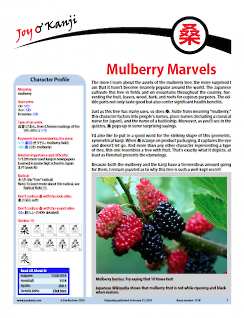桑
mulberry
Kanji 1518
Thank you for visiting this Character Home Page. Below you'll find a synopsis of the essay. If you wish to read the full text, the PDF of the essay is available for purchase to the right.
The Japanese have found uses for every part of the mulberry—the fruit, leaves, wood, bark, and roots. In Japan, mulberries have been so important that some maps mark mulberry fields. Aside from its mulberry connections, 桑 factors into the names of several significant places, including San Francisco and Japan itself! Our kanji also pops up in surprising sayings and a famous bit of wordplay.
Revision history:
Mar. 27, 2025: p. 6: Fixed a broken link.
Nov. 26, 2024: p. 6: Removed a broken link.
June 21, 2024: pp. 3 and 4: Changed "charm" to "chant."
Jan. 29, 2021: p. 11: Fixed a typo.
Jan. 13, 2020:
- p. 2: Etymology Box: Replaced the old Henshall etymology with the new one and reworked the whole Etymology Box.
- pp. 10–11: Made small revisions to the Fuso discussion, including adding a paragraph about Fuso trucks.
- p. 16: Added a link to the Kanshudo games.
Feb. 26, 2016: p. 7: Deleted the part about the mulberry trees on Hachijo Island after learning that the famous yellow silks from Hachijo don't get their yellow hue from the mulberries there. Rather, the hue comes from a grass called コブナグサ (Arthraxon hispidus Makino).
Feb. 13, 2016: Originally published.



Comments